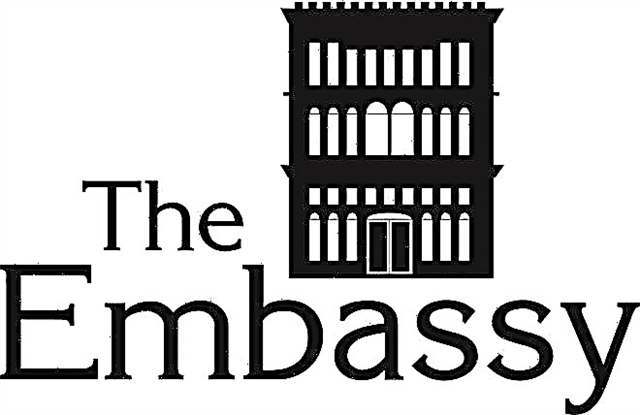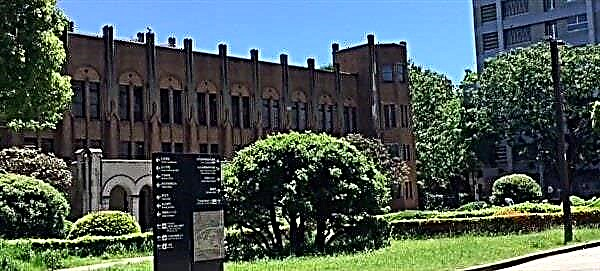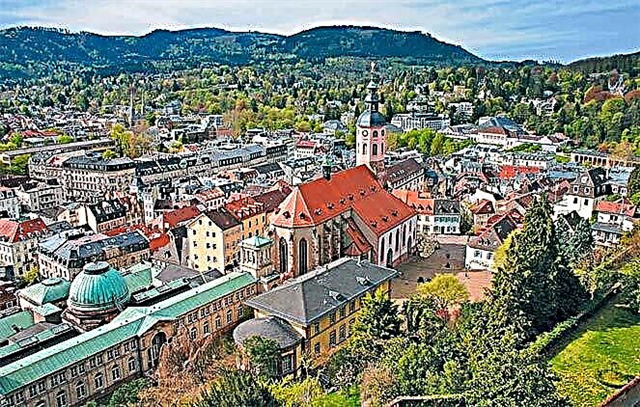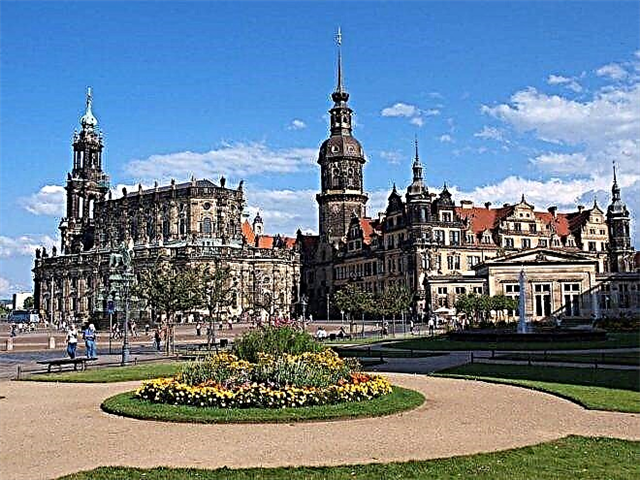Dresden is the world famous city on the Elbe, which is a real treasure trove of attractions. It is here, in the capital of the state of Saxony, that the Dresden castle-residence is located - the oldest building, the estimated age of which is nine hundred years. Located in the heart of the picturesque city, it is a popular tourist destination for visitors from all over Germany.

The centuries-old history of the palace
According to historical and scientific chronicles, the first reliable written records of the majestic Dresden Castle date back to 1289. However, many historians and scholars make bold assumptions that it was originally a Romanesque fortress, built at the end of the 12th century.
The impetus for such reasoning was the study of the early elements of the castle and the foundation, but, unfortunately, no written or artistic evidence of this has survived to our time.
For several centuries in a row, starting from the XIII century, the building was reconstructed, which changed its original appearance. Already in the 15th century, it was transformed into a four-sided three-story castle.
It acquired its proud name of a palace-residence for a reason, being the residence of the electors (in the periods from 1464 to 1485, and from 1547 to 1806) and the kings of Saxony (from 1806 to 1918).
From the 16th to the 20th century, waves of numerous large-scale reconstructions are mentioned, at the same time the surrounding buildings are being erected and the buildings adjacent to the palace are being erected. The last restoration, which began in 1889, lasted a decade and gave the castle a look that has survived to this day.
What makes Dresden Castle so special
The general territory of the castle is an architectural ensemble of many building parts, including the Watchtower, the St. George's Gate and the courtyard, surrounded by four sides, each of which has its own characteristics and is connected by a passageway with a building close to it. The exterior of the castle is varied. The reason for this was the construction work carried out in different centuries, each of which left its own unique, inimitable imprint.

Despite the multitude of colors, stucco and mosaics, vaults and domes that range from Gothic to eclectic style, the overall appearance of the palace is completely harmonious.
When visiting the palace-museum, it is worth paying attention not only to the architecture, but also to the interior decoration.
Within the walls of the Dresden Castle, the Art Library, the Engraving and Numismatic Rooms, the world-famous collection of jewels "Green Vaults" (Grünes Gewölbe), the Turkish and Armory Chambers, operate and receive visitors.
Many museum exhibitions are located side by side, which allows you to see a significant number of attractions in a day and get wonderful, unforgettable impressions from this.
Internal organization of the Dresden castle-residence
As already mentioned, the area occupied by the building is not quite small, due to centuries of completion and reconstruction. Each architectural element of the Dresden Castle has acquired an exceptional style and distinctive features. It is worth noting the fact that when you find yourself in different parts of the palace, it seems that they all belong to completely different buildings - the difference between architectural styles can be so strong.
George's gate and gate palace
On the banks of the Elbe, between Brühl's terrace and the church, is the north side of the palace. The exterior of the castle here is rather gloomy, as the walls are built of sandstone, which has darkened over the years.
One of the main attractions of the Dresden palace-residence - St. George's Gate - are actually arches, which are decorated with stucco and carved statues.
Until the middle of the 16th century, the gates were called Elbe, according to their location on the banks of the river of the same name. But in the period between 1530-1558, at the behest of the Saxon Duke George the Bearded, cardinal reconstructions were made, and the gates were renamed and from that moment they were called St. George's. They were a thoroughly fortified structure, since they were the main entrance to the ducal domain.
Above the gates there is a palace room of several floors, with narrow rectangular windows. It rises up and gradually takes on a triangular shape, crowned with a spire.
The facade is decorated with statues of two knights, between which is a statue of George the Bearded himself.
After passing through the St. George's Gate, visitors find themselves on an inner street connected by a passageway with the Konyushenny yard and the treasury. While in the square palace, tourists can visit the Numismatic Office and an exhibition of art creations that were previously the dignity of the Royal Kunstkamera.
Gausmann's tower
From the inner street of the palace, there is a beautiful view of the exquisite Renaissance tower - the Gausmann tower. Initially, erected in the XIV century, it was part of a defensive complex and served as a guard post. In the years 1674-1676, it was supplemented with a top with a spire, while the weather vane is located at a height of just over a hundred meters.
Until the end of World War II, the Gausmann Tower was the tallest structure in Dresden.
But the bombing in February 1945 caused significant damage to the structure. At that terrible time, elements such as the dome and chimes were destroyed.
The architecture of the Dresden Castle was gradually restored. Only in the early 90s of the last century, Gausmann's tower was finally reconstructed and acquired a copper spire, the height of which is 30 meters, a clock mechanism and a figured weather vane.
Moritzbau or the modern wing of the west side
At the end of the 16th - beginning of the 17th century, Elector Moritz decided to expand the territory of the castle. He recruits three architects to carry out this task at once: Hans von Den-Rotfelsen, Bastian and Hans Kramer. In connection with the grandiose reconstruction, the western wing was destroyed in order to eventually build a new expanded part on the site of the demolished building, which was named Moritzbau.
Additionally, the northern and southern wings were completed in order to form a closed courtyard. According to some historical information, it was planned to hold knightly tournaments here.

At the moment, the western wing is crowned with an ensemble of three towers, the main role among them belongs to the above-described Gausmann tower. Chambord French castle served as a model for their construction.
In the center of the tower facet is a statue of a lion, over which, decorated with gold, the monogram AR is affixed, which served as a designation of the belonging of the building to the Elector Augustus the Strong.
On the right side of the newly erected western wing, there is a covered walkway connecting the residence and the Taschenberg Royal Palace. Thus, the residence of the nobility had a connection with the castle and the cathedral in the form of air passages.
Green Vaults Treasury and Domed Courtyard
The first floor of the western wing is distinguished by the special character of the buildings. The main feature is a meter thick, reliable walls, erected in order to keep the royal treasures safe. August the Strong and his heir August III had an interesting hobby - collecting precious works of art. Centuries later, the repository was converted into the Green Vault Museum.
The number of exhibits in the museum is significant. Each of them has its own history and great value.
The most famous compositions are "The Courtyard of the Great Mongol in Delhi" and works by the personal jeweler of August the Strong - Dinglinger.
According to one of the stories, the Russian Emperor Peter I, visiting the treasury of the King of Saxony, spent the whole night in these halls. It was extremely difficult for the sovereign to break away from gazing at the exciting and attractive jewels.
The road to the museum goes through the Georgievskie gates, an inner street and a special covered courtyard. It is called the Small Courtyard and its peculiarity lies in the glass ceiling. Columns of yellow stone rise to it, which are the ancient part of the building.
The modern glass dome and the load-bearing parts of the old structures create an extraordinary mixture of styles and eras.
Mosaic wall "Procession of Princes"
The exterior of the castle has one more attraction - the art mosaic “Procession of Princes”. It is located on the outer wall of one of the galleries and stretches 102 meters.
The painting has been located here since 1589, but at that time it was done with lime paints. In 1872, the artist Wilhelm Walter began work on an enlarged and improved painting using the sgraffito technique.
After 30 years, it was decided to transfer the image to ceramic tiles. The panel consists of 25,000 perfectly laid tiles made from local Meissen porcelain. It is the largest such work of art in the world.
“Procession of Princes”, as the name suggests, depicts a magnificent procession reflecting the thousand-year history of the reign of the princely house of the Wettins.
The panel contains not only the electors and kings of Saxony, but also images of their retinue: artists, soldiers, scientists, peasants, representatives of universities and gymnasiums.
How to get to the Dresden residence castle on your own
From almost anywhere in the city, you can comfortably reach the historic Dresden Castle complex. It is located at Taschenberg, 2.
You need to take any of the trams 4, 8 or 9, get off at the Theaterplatz stop. Then walk 100 meters along Sophienstraße towards Taschenberg. It is impossible to get lost or get lost, since the castle can be seen from afar thanks to its high spiers, which will serve as a wonderful landmark.
Visiting excursions
All exhibitions and museums are open all week except Tuesday. On this day, the architectural complex is closed. The opening hours of the Green Vault Museum-Treasury, the Numismatic Office, the Armory Chamber and the Engraving Office are from 10.00 to 18.00.
The ticket price is 12 €. The ticket includes admission to 9 thematic rooms.
At the entrance you can get an audio guide in any of the desired foreign languages, including Russian.
Dresden has an extensive system of discounts and favorable opportunities for city visitors. Travelers can purchase a ticket for 30 €, which makes it possible to visit all the museum complexes of Dresden throughout the day without any other surcharges.
Conclusion
Dresden Castle Residence is an incredible place with a rich history and varied architecture. It is definitely one of the must-see places in Dresden.
The convenient location in the center allows you to enjoy not only this wonderful structure, but also the nearby Hofkirche, the Semper Opera House and the Zwinger Gallery. Therefore, once in Dresden, you should definitely plan a visit to the magnificent old city center right away.











